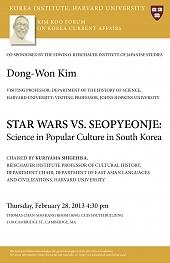Date:
Location:
Kim Koo Forum on Korea Current Affairs

Dong-Won Kim
Visiting Professor, Johns Hopkins University; Visiting Professor, Harvard University
Dong-Won Kim was born in Seoul, South Korea, in 1960. He studied computer science and statistics at Seoul National University (BS) and history of science at Harvard University (AM, Ph.D.). His doctoral thesis is on the early history of the Cavendish Laboratory at the University of Cambridge. After returning to Korea in 1991, he taught at Seoul National University, Korea Advanced Institute of Science and Technology (KAIST) and several other universities. He became an assistant professor of history of science at KAIST in 1994 and taught there until the end of 2004. Since 1993 he has worked on the histories of Korean and Japanese science and technology, and published several papers and a book on the topic. He has also taught the history of East Asian science and technology in the modern period since 1998 at Johns Hopkins University and KAIST. In 2005 he moved to the United States to become an independent scholar. He returned briefly to KAIST to serve as Dean of the College of Cultural Science (2009-2012). He is now working on the history of cosmic rays in the 20th century with special emphasis on Japan’s role.
Chaired by Kuriyama Shigehisa, Reischauer Institute Professor of Cultural History; Department Chair, Department of East Asian Languages and Civilizations, Harvard University
Abstract
The Star Wars movie series and the Star Trek television series and movies have never been popular in South Korea. The six Star Wars movies were unexpected failures there, and few Star Trek movies and TV shows have been shown in South Korea. While Japanese have been very enthusiastic about Star Wars and Star Trek, South Koreans’ lack of interest is very unique. At the same time, Korean movies that emphasize Korean traditions and/or values in the past have flourished since the early 1990s. Seopyeonje, released in 1993, was the first Korean movie that attracted more than 1 million viewers in Seoul alone. Many Korean movies since then have become mega-hits but the Star Wars sequels, Episode 1, 2, 3, attracted fewer than total 2 million movie-goers. How are these phenomena related to the popular image of science and technology in South Korea? Are these phenomena related to Korea’s “crisis in science and technology” in the 21st century? How much did the changing political situation in the latter half of the 20th century influence the image of science and technology in Korea?
Co-sponsored by the Edwin O. Reischauer Institute of Japanese Studies
The Korea Institute acknowledges the generous support of the Kim Koo Foundation